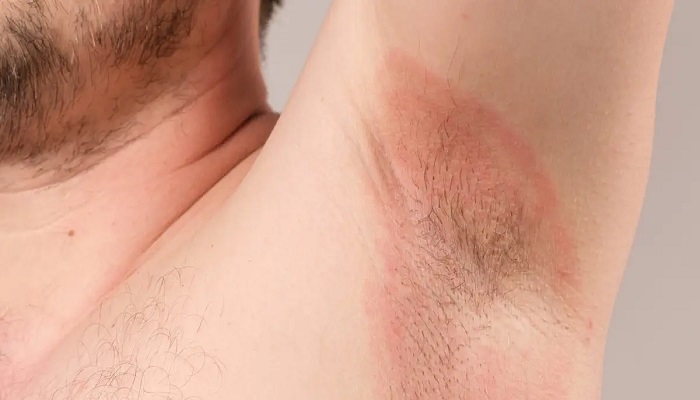Do you have a lingering rash in your armpit that won’t disappear? Are you suspicious that a fungus may cause it? You are not alone. Many people experience redness, itchiness, and discomfort in their underarms due to an overgrowth of fungi. It can be very uncomfortable and painful at times – luckily, help is available.
In this article, we will give you all the information you need to answer the question: How do I know if my armpit rash is fungal? We’ll cover what causes these unwelcome fungi rashes, how to diagnose them properly, and review some treatment options. So let’s start learning about fungal armpit rashes so you can finally find relief from discomfort and gain back confidence.
Signs and symptoms of a fungal armpit rash
Having a fungal armpit rash can be both uncomfortable and embarrassing. Typically, signs and symptoms include an itchy or burning sensation and an area of reddened skin with visible scaling or peeling. The rash may form into a large patch or small bumps, and it can sometimes look like tiny clusters of red bumps that resemble acne.
Additionally, for some people, a moist discharge is accompanied by a pungent odor due to the overgrowth of fungus in the area. If you experience any of these symptoms, it’s best to consult with your healthcare provider, who can prescribe topical antifungal agents and other treatments if needed. Eczema under arm also might be a common symptom of fungal rash.
Causes of a fungal armpit rash
A fungal armpit rash can be a frustrating and annoying condition to deal with. It is often caused by excessive bodily humidity, along with tight clothing and materials that trap the sweat close to the skin. These conditions create an environment ripe for fungus to form and grow, leading to the development of a rash. Other potential causes include prolonged antibiotic use, which disrupts the body’s balance of bacteria and can enable the fungus to take hold.
Individuals who consume high amounts of sugar or carbohydrates may also be more likely to have fungal rashes in their armpits due to increased yeast growth. No matter the cause, it is vital to properly treat a fungal armpit rash due to its contagious nature and long-lasting symptoms.
How to diagnose a fungal armpit rash
Diagnosing a fungal armpit rash is relatively straightforward, and your healthcare provider can perform a physical examination and swab the affected area to collect fungus samples. The sample will be sent to a lab for testing, which should confirm whether it is a fungus causing your symptoms.
Your doctor may also prescribe medications such as antifungal creams, powders, or shampoos containing an active ingredient to treat fungal infections. Suppose your condition does not respond to these treatments after several weeks. In that case, you should ask your healthcare provider about other treatment options, such as antibiotics or oral antifungal drugs.
Treatment options for a fungal armpit rash
Once a fungal armpit rash is diagnosed, treatment must begin immediately. It will help reduce the severity of symptoms and lessen the risk of it spreading to other parts of your body or someone else’s.
The most common treatments involve using antifungal creams, powders, or shampoos. These products are formulated to attack the fungus on contact and can be applied directly to the affected area. Your healthcare provider may also prescribe oral medications such as terbinafine or fluconazole that attack the fungus from within. Additionally, there are natural remedies that you can try at home, such as apple cider vinegar, garlic paste, tea tree oil, and coconut oil – all of which have antifungal properties.
Whichever treatment you choose, following the directions provided by your healthcare provider and the product’s packaging is crucial. Keep the affected area clean and dry to prevent further growth or spread of the fungus.
Home remedies for managing your symptoms
In addition to antifungal treatments, there are some home remedies that you can use to manage and reduce the symptoms of a fungal armpit rash.
Using talcum or baby powder in your armpits can help absorb extra moisture and keep fungus from forming. Additionally, wearing breathable materials like cotton instead of synthetic fabrics can be beneficial as they will allow air to circulate and keep sweat away from the skin.
If you have a rash, apply natural ingredients such as tea tree oil or garlic paste directly to the affected area for relief. It may also help reduce scaling and peeling caused by a fungal infection. Finally, it is crucial to practice good hygiene habits such as washing all clothing, towels, and bedding with hot water, using separate towels for each person in the household, and keeping your skin clean and dry.
Tips for preventing future outbreaks of a fungal armpit rash
The best way to prevent future outbreaks of a fungal armpit rash is to practice good hygiene habits and minimize your risk factors.
Keep your body clean and dry, especially in areas where sweat can accumulate, such as the armpits. Wear breathable materials like cotton instead of synthetic fabrics, and avoid tight-fitting clothing that prevents air circulation. Additionally, try to reduce sugar and carb intake as much as possible since this can cause yeast growth, leading to fungal infections.
Finally, make sure to properly dispose of all used tissues, towels, washcloths, etc., and replace them regularly with fresh ones to prevent the further spread of the fungus. If you have any questions or concerns about how to prevent or treat a fungal armpit rash, contact your healthcare provider for more information.


















